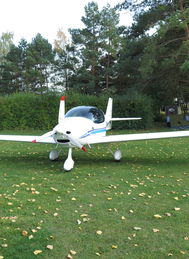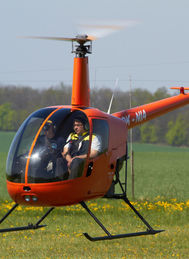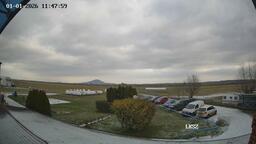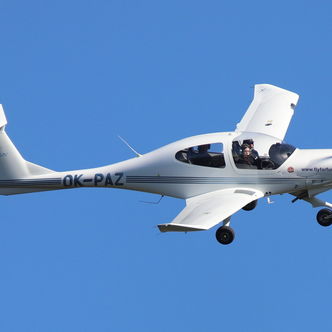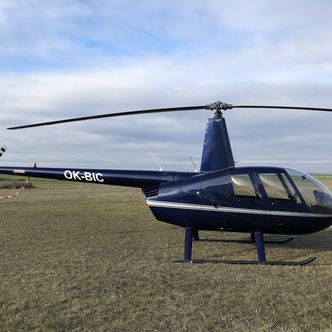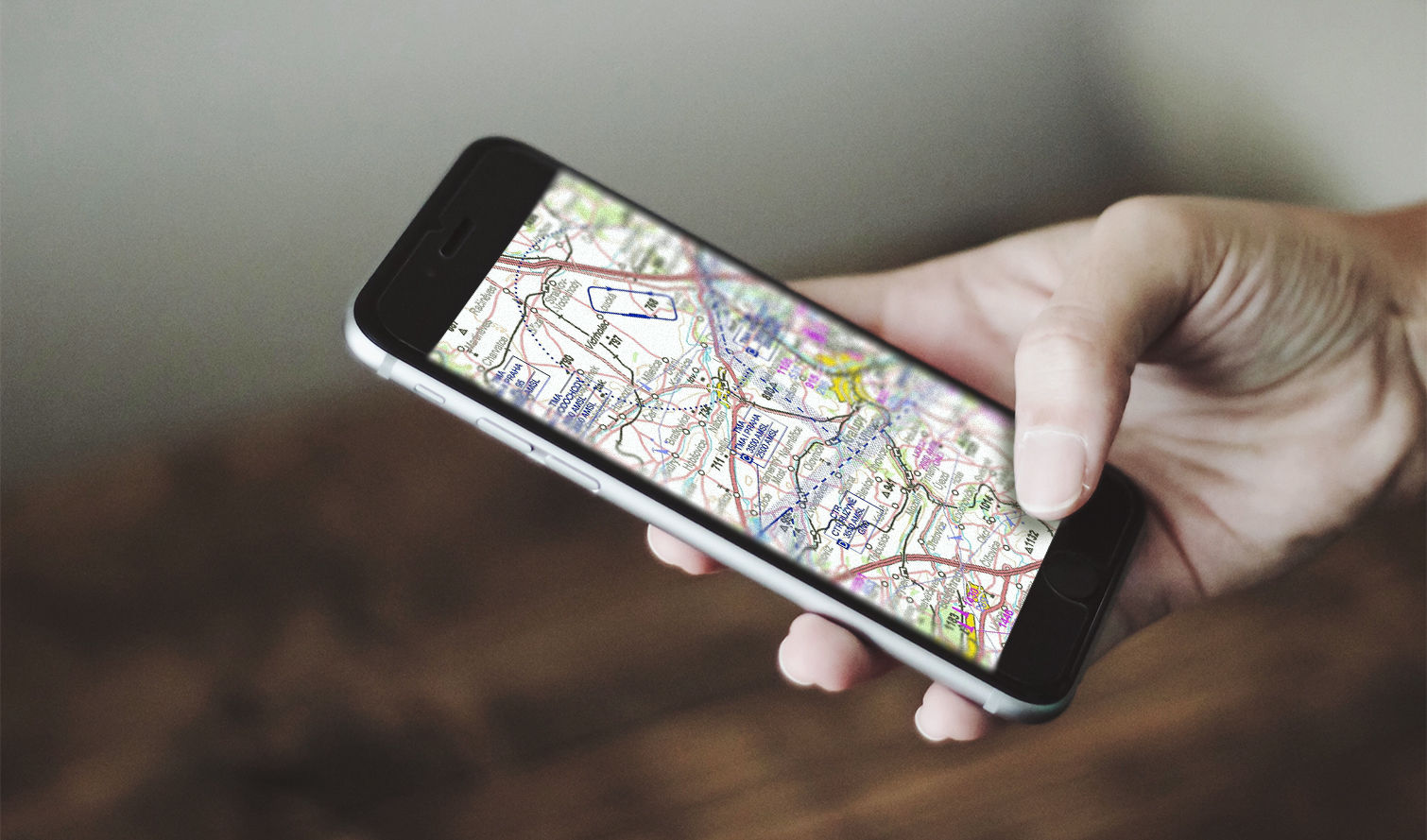A Flight into the 14th Century
We offer a unique opportunity for you to visit, by plane, several historic and interesting places in Central Europe.
Saint George Rotunda - Říp
 The rotunda is first mentioned in 1126 when Prince Soběslav the First, ordered the reparation of this little church and add the western-style round spire in remembrance of the victory in the Battle of Chlumec. Given this historical fact it is safe to assume the building was founded before 1039 when the remains of Saint Adalbert were transported to Prague, and to whom the chapel, in Říp, was previously dedicated. It is known that only from the 16th century was it dedicated to Saint George, the patron of the Premyslid dynasty. The church became an established place of pilgrimage during the 17th and 18th centuries.
The rotunda is first mentioned in 1126 when Prince Soběslav the First, ordered the reparation of this little church and add the western-style round spire in remembrance of the victory in the Battle of Chlumec. Given this historical fact it is safe to assume the building was founded before 1039 when the remains of Saint Adalbert were transported to Prague, and to whom the chapel, in Říp, was previously dedicated. It is known that only from the 16th century was it dedicated to Saint George, the patron of the Premyslid dynasty. The church became an established place of pilgrimage during the 17th and 18th centuries.
The ‘Water’ Castle Budyně
 This, originally wooden, castle was the property of Czech royalty. At the beginning of the 12th century the Czech king Ottokar I rebuilt it in stone in the gothic style. In 1316 John of Bohemia captured Budyně Castle and in 1336 sold it to Zbyněk Valdek of Hazmburk, a member of the Zajíc family from Hazmburk. During this family’s reign the castle underwent the most progressive period of redevelopment.
This, originally wooden, castle was the property of Czech royalty. At the beginning of the 12th century the Czech king Ottokar I rebuilt it in stone in the gothic style. In 1316 John of Bohemia captured Budyně Castle and in 1336 sold it to Zbyněk Valdek of Hazmburk, a member of the Zajíc family from Hazmburk. During this family’s reign the castle underwent the most progressive period of redevelopment.
In the second half of the 15th century Jan Zajíc built a ‘late’ gothic castle surrounded by a wall and a moat. Zajíc had an important job as a court judge, but he opposed King George of Poděbrady and even supported the Hungarian sovereign Matthias Corvinus in 1469. For this reason the castle was surrounded by the royal army, but Jan Zajíc managed to escape to Žitava.
In 1551 the castle’s gunpowder store exploded, which led to the damage of its stone walls. In the second half of the 16th century it was rebuilt as a Renaissance castle. However, the then owner. Jan Zbyněk Zajíc of Hazmburk, ran into heavy debt due to the costly reconstruction and had to sell all in 1613 to the Šternberk dynasty. Adam of Šternberk became the new owner and he merged the Budyně and Libochovice estates which led to neglect and the subsequent ruin of the castle. During the Thirty Years’ War there were several attempts to capture Budyně, and finally it was plundered by the Saxons. After the war the castle was used only as the sherrif’s seat and for his clerks. In 1676 Gundakar of Dietrichtstein bought Budyně as part of the Libochovice domain and it underwent some modifications in the baroque style (Antonio della Porta). In 1759, during the Seven Years’ War, the castle was badly damaged by fire when it was encircled by the Prussians. In 1823 the eastern and southern wing, together with the tower, were demolished. In the years 1900 to 1913 there was a major reconstruction by the new owners of the property: the Heberstein dynasty. The Renaissance interiors were restored in the years 1908 to 1913 by R. Říhovský.
In 1945 it became the property of the town of Budyně. What we see today is the result of the reconstruction made during the 1970s and 1990s in which, for example, the wall was rebuilt. After the Herberstein dynasty claimed the property during the Restitution, the court decided on 27th September 1994 the property belonged to the town. The most important aspect of the castle is the Golden Hall which features Renaissance paintings illustrating architecture and scenes from the life of nobles in the 16th century.
Hazmburk
 The castle proper was probably built in the first half of the 14th century by the Lichtenburks. However it can’t be denied that the castle has some similarities with the royal castles from the second half of the 13th century, such as the castle Osek. This suggests that the founder could well have been King Wenceslas II. Hypothetically, we could also link the construction of the building to 1292 when Heiman of Lichtenburk gave certain rights to the nearby town of Libochovice.
The castle proper was probably built in the first half of the 14th century by the Lichtenburks. However it can’t be denied that the castle has some similarities with the royal castles from the second half of the 13th century, such as the castle Osek. This suggests that the founder could well have been King Wenceslas II. Hypothetically, we could also link the construction of the building to 1292 when Heiman of Lichtenburk gave certain rights to the nearby town of Libochovice.
The first written document giving hard evidence of the castle’s existence is from 1335. King John of Bohemia, who ruled the domain through an exchange from Hynek of Lichtenburk, and shortly after sold the castle, the Klapý village, the Libochovice fort, and the town and four villages to Zbyněk Zajíc of Valdek. Zbyněk renamed the castle Hasenburg depicting the family coat of arms in which a hare is pictured (the German word for a hare is Hase). From 1337 (other sources mention only from 1341) he started to adopt the title of Hazmburk. The castle became the family seat of Zajíc of Hazmburk who owned it until 1558. After the death of Zbyněk in 1368 his son Vilém Zajíc of Hazmburk, together with his nephew Mikuláš (his brother’s Vilém’s son Jan) were owners. In 1379 Mikuláš left for Budyně and became the founder of the Budyně lineage. In 1393 Vilém’s sons Zbyněk, Oldřich, Vilém (junior), Mikuláš, Jaroslav and Jan divided the castle into six parts. Oldřich, little by little, bought the shares from his brothers, except for Vilém. Jan and Mikuláš bought Kost Castle. Vilém bought Šebín Castle (which was in the vicinity) in 1415. However, when Oldřich died in September of the same year, Vilém inherited the entire Hazmburk estate.
At the beginning of the Hussite Wars, the Zajíc of Hazmburk were on the catholic side. The Hazmburk and Budyně castles and the town of Libochovice meant support for the emperor Sigismund of Luxembourg. William Zajíc of Hazmburk ruled the town of Slaný in 1420 where the emperor agreed to a truce with the town of Louny. In 1424 Jan Žižka attempted to capture Libochovice. However, he failed to surround and seize the castle. The Hussites unsuccessfully tried to seize the castle for the second time in 1429, and two years later they destroyed the surrounding villages. In the same year it is believed Vilém died and the castle passed to his son Zbyněk of Hazmburk.
In the third part of the 15th century the town of Podhradí grew on the south-east side of the castle hill where a church dedicated to Saint Nicholas was situated. When the Hussites captured Libochovice Castle, it lost its economic and business power although the castle garrison still needed the services of the craftsmen and businessmen. The solution was found by establishing a fortified settlement close to the castle. At the beginning of the 16th century, a calmer and quieter period allowed the town of Libochovice to prosper once more and Podhradí declined and all but disappeared. The town is documented as being deserted in 1550 and 1553. All that remained was the perimeter wall with a tower, and bastions in two of the corners.
Zbyněk of Hazmburk expanded his dominion by incorperating several villages that originally belonged to the church, and in the years 1456 to 1459 he ruled Hněvín Castle in the name of the crown. He also appropiated Budyně Castle. He died childless and left all his property and possessions to his uncle Mikuláš’s of Hazmburk and his sons who lived in Kost Castle. The Hazmburk family included Jan who was an important member of the Zelenohorská union (opposed to King George of Poděbrady). The king Matthias Corvinus named him Chancellor, and the Hungarian garrison resided in Hazmburk Castle. In the times of Vladislav Jagiellon, Jan of Hazmburk became judge of a provincial court. His son Jan junior of Hazmburk and his grandson Christopher of Hazmburk didn’t live in the castle as they moved to the more comfortable Budyně Castle which was reconstructed in the Renaissance style. Hazmburk Castle was probably maintained for some short time even after it was deserted. However, in 1586 it is described as being empty and abandoned. By then it was already part of the estate of the Lobkowicz dynasty who bought it from Kryštof of Hazmburk in 1558, and merged it within the Libochovice dominion.
The Ruins of Košťálov Castle
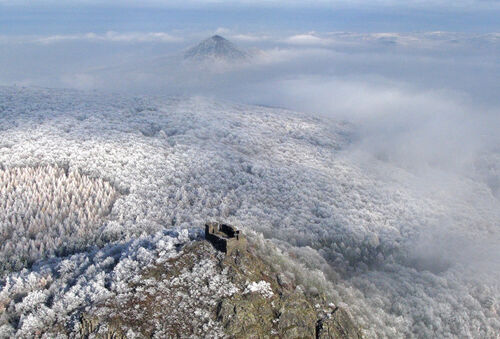 Although the castle is first mentioned in writing in 1372 the construction suggests it originates from the 14th century. Neither the builders nor the original owners of Košťálov Castle are known. The chronicler Beneš Krabice of Veitmile tells us that the castle was struck by lightning, and burnt the govenor Aleš’s and his wife’s shoe tips. Aleš is mentioned in connection with the castle again in 1378 and 1380. Firstly, due to a disagreement with a church cleric he was exiled from the church. If Aleš of Slavětín was govenor of Košťálov he couldn’t have been the owner of the castle and was therefore only administrating it. Because there are no clear written records about the owners of Košťálov we can only speculate, through books, that the founders might have been the Zajíc of Hazmburk or Kaplíř of the Sulevice and Slavětín dynasties. František Alexandr Heber, the author of the first listing of Czech castles, was convinced Košťálov was founded by royalty, but it’s improbable considering the property structure of the surrounding estates.
Although the castle is first mentioned in writing in 1372 the construction suggests it originates from the 14th century. Neither the builders nor the original owners of Košťálov Castle are known. The chronicler Beneš Krabice of Veitmile tells us that the castle was struck by lightning, and burnt the govenor Aleš’s and his wife’s shoe tips. Aleš is mentioned in connection with the castle again in 1378 and 1380. Firstly, due to a disagreement with a church cleric he was exiled from the church. If Aleš of Slavětín was govenor of Košťálov he couldn’t have been the owner of the castle and was therefore only administrating it. Because there are no clear written records about the owners of Košťálov we can only speculate, through books, that the founders might have been the Zajíc of Hazmburk or Kaplíř of the Sulevice and Slavětín dynasties. František Alexandr Heber, the author of the first listing of Czech castles, was convinced Košťálov was founded by royalty, but it’s improbable considering the property structure of the surrounding estates.
Further information on the castle dates from the times of the Hussite Wars. Sedláček writes about the Hussite troops camping at the castle in 1422. One year later Jan Kaplíř is mentioned as the owner of Třebenice and the surrounding villages, so theoretically he could also have been the owner of Košťálov.
In 1486 the castle looked like a residential manor house. At that time the three Kaplíř brothers divided the castle up: the eldest Zdislav resided in the palace of the upper castle while Dobeš and Jan were each in a separate house in the lower castle. The Kaplíř family remained owners of the castle until 1609 when Adam of Vchynice took possession of it. At that time the castle wasn’t occupied.
Due to the difficulties in reaching the castle the nobility found it impracticle as a residence. Some time in the first half of the 16th century the Kaplíř family built a small palace in the village of Košťálov close to the castle and lived there. Owing to a lack of of maintanence the castle fell into ruin and by1622 was already deserted.
Karel Hynek Mácha who visited the castle was attracted by its romantic location. He twice drew Košťál Castle in his notebook in 1833: once with the town of Třebenice and Skalka Castle and once with the castle alone. Emil Filla painted Košťálov Castle several times in the 50s in his series of pictures of the Central Bohemian Highlands using the technique of wet brush and Indian ink.
The history of the foundation of Košťálov Castle in the 8th century was documented by Václav Hájek of Libočany in his chronicle which was published in 1541.
The Ruins of Oltářík Castle
 The Hussite sheriff Jakoubek of Vřesovice is considered to be the founder of the castle but there is no real documentation proving it. He probably ordered the construction of the castle in the years 1434 to 1438. The reason he built the castle was perhaps to secure his property at a time when he was in dispute with the Žatec and Louny Union. The Jakoubek’s family estate in the Central Bohemian Highlands were: from 1434, Kostomlaty Castle, Liběšice, Chouč, Skršín, Lahovice and Řisuty, and from 1450, Chrášťany and Děkovka.
The Hussite sheriff Jakoubek of Vřesovice is considered to be the founder of the castle but there is no real documentation proving it. He probably ordered the construction of the castle in the years 1434 to 1438. The reason he built the castle was perhaps to secure his property at a time when he was in dispute with the Žatec and Louny Union. The Jakoubek’s family estate in the Central Bohemian Highlands were: from 1434, Kostomlaty Castle, Liběšice, Chouč, Skršín, Lahovice and Řisuty, and from 1450, Chrášťany and Děkovka.
The first written account of the castle dates from 1450 when Jakoubek of Vřesovice with his son Jan pledged it for 18000 groschen/grosz to Jan of Polensko who lived in the fort in Vršovice. The villages Chrášťany and Děkovka were also part of the castle’s lands. Jan’s son, Mikuláš of Polensko, was forced to sell Oltářík to the brothers Jan and Oldřich Zajíc of Hazmburk in 1468. From 1468 to 1531 there is no further information about the castle. For the Lords of Hazmburk the castle had primarily a military purpose and was used to protect the Třebenice estate. It stayed as such for the subsequent owners who were the Lords of Illburk. We can only speculate whether they felt the necessity to maintain an old, small castle. They probably claimed the castle in 1476 when Vilém senior of Illburk was promissed Třebenice. Less probable is that Vilém junior of Illburk bought the castle in 1505 when he sold the Mšené dominion to the family Zajíc of Hazmburk allowing him to buy Oltářík.
Vilém Junior of Ilburk and Ronov left the castle to his wife Anežka of Helfenštejn in his will in 1531. When the will was read the castle is mentioned as being deserted. According to Dobroslava Menclová the castle was already abandoned by 1468, but according to August Sedláček it was only after 1531. It’s unknown how but after Anežka’s death Volf of Vřesovice somehow claimed the castle and allowed a anonymous nobleman to use the title “of Oltářík”. The last mention of the castle dates from 1612 when it was used as a storehouse. How it was left to deteriorate is unclear. It’s possible the castle was falling apart and a fire hastened its abandonment. It is also possible it was hit by lightning and caught fire after it was already unoccupied.
The castle stands on a isolated granite rock. Its lofty position on the rock meant potential invaders couldn’t use their armoury effectively, and it was substantial protection against the increasing sophistication of guns in the Hussite Wars. Supplies to the castle came from the surrounding villages Chrášťany and Děkovka from which roads led to the valley between Dlohý vrch and Oltářík where they met the acces path to the castle.
The first thing you see are the remains of the gate and the residential tower. The original castle however was much more sophisticated and extensive in design. Other buildings within the complex were made mostly from wood or dry stone and are therefore only visible as remnants in certain places. Sporadic traces of the wall can be found in places where the stone adjoined the rock.
The first visible part of the castle we see might have been the access path on the southern and eastern sides of the hill. This theory is based on the existence of a partly remaining retaining wall by the road. In the east, where the road is squeezed between the retaining wall on the left and a rock formation on the right, there could have been the main gate which would have protected the access to other parts of the castle. On the west side the access is blocked by a barely noticable 30 meter rampart at the edge of a terrace covered with loose scree.
From the top of the hill, facing north-east, there are remains of the fortification which was a dry stone retaining wall. The construction was most probably built with an embankment, strenghtened with dry stone, the front of which only the lower part of the outside layer is preserved. This was how the base, which held a timbered wall of the front with loopholes, was made. The entire construction meant the wall was resistant to sustained firing from the ground. The wall seperated the access path and ran parallel to it up to the second gate. In one of the rocks there is a visible trace of a partly bricked insert/recess into which a beam of wood would have been secured. To reach the other side of the castle access was through the second, partly preserve, gate of which the arch was still visible in 1846. The width of the passageway is today between 170 cm and 177 cm but if we suppose the original width to be between 117 cm and 137 cm. it’s possible the gate had a barell vault.
Behind the gate the path separates into two directions. One follows in the direction of the third gate, long since disappeared, and the second runs in a southwesterly direction to an artificially leveled area near the top of the rock where, probably, some functional buildings were located but have now disappeared without a trace. Further up from this area there is the castle proper, formed by a tower and a small courtyard to the east of it. The courtyard used to be fortified by a wall which shows a 1.2 meter wide cut in the rock and a small fragments of masonry in places where the wall had been connected to the southeast corner of the tower. In the northeast section of the wall there was very probably a fourth gate.
The best conserved part of the castle is the residential tower, built to a plan in a trapezium shape 15.3 by 11.3 meters, and an outside wall 1.6 meters wide. The wall follows the rugged terrain and was built in just one phase of construction. The south-east corner is better constructed and strengthened as it was more exposed. The entrance to the ground floor was in the northern part of the eastern facade where a recess for the closing beam is still visible. Several recesses for the beams which were supporting the floor of the ground level are still visible. Two of them contain mortar and traces of fire. There was only one room with one window on the ground level. From this room a staircase led down into the basement which was lit only by two slotted windows. One of these windows remain in the southern wall while the second partially dissapeared when the new entrance to the tower was built.
The living rooms were on the first floor which no longer exists. The castle was not frequently damaged and the fragments of brick found on the slopes under the hill show that it was half timber and masonry. There is a block of masonry attached to the southern part of the tower close to the southwest corner that could have been a buttress or was supporting a half-timbered bay.
The Ruin of Kalich Castle
The first written mention of Kalich dates from 1421 and can be found in the Hussite Chronicle written by Vavřinec of Březová. It was founded by Jan Žižka the Hussite sheriff as his family seat in the times before the Hussites besieged the town of Litoměřice. One reason for the new castle was protection from the attacks of the catholic nobility from northwest Bohemia. In September of the same year Zikmund Děčínský of Vartenberk had already tried to capture it, but was unsuccesfull. In 1422 Jan Žižka started to use the title of Kalich.
It was most likely that in the times of the siege Zikmund of Vartenberk founded Panna Castle on a neighbouring hill and probably, between the years 1423 and 1427, Litýš Castle also. Two catholic castles in close proximity meant a threat to the Hussites, and for this reason they attempted to také Panna Castle. However, they were without success. Žižka’s troops only managed to capture it after a month of seige in 1423.
Jan Žižka died in 1424 and probably handed over the castle to his brother, Jaroslav of Kalich. After Jaroslav’s death in 1428, Žižka’s sister Anežka became the new owner/occupant along with another relative, Anna. Their lives have not been chronicled in detail, but we do know that in 1434 Anežka tried unsuccessfully to acquire a house in Prague ‘New Town’ through a legal dispute. It is asumed that the castle garrison participated in smaller military operations in northwest Bohemia, and probably in the battle in Ústí in 1426. In 1437 Zikmund of Vartenberk captured and then destroyed Panna Castle. There are reports stating that at the same time even Kalich Castle was captured and destroyed but these reports were unfounded. The castle was captured but was probably given to Heník of Valdštejn to whom the emperor Zikmund pledged the Býčkovice estate.
After 1438, the owner of the castle was Vilém of Ilburk but when, why and how he became owner is not clear. We know for certain Vilém had it in his possession in 1444 as he was known by the title Kalich. He ordered a major reconstruction of the castle, but it’s likely he considered it more of a strategic and military bastion than a comfortable place in which to live. Later on Vilém stood against King George of Poděbrady. Although there is no documented evidence it is believed Kalich was either captured or handed over without a fight to the royal troops that captured the neighbouring towns of Roudnice and Helfenburk in 1467.
Although Petr Kaplíř of Sulevice was promised the castle by the King, he lived mainly in VImperk and Kalich was used mainly as a fortress. It is not known how but the next owner from 1471 to 1488 was Ješek Svojanovský of Boskovice who also didn’t occupy the castle. Although the castle was unlikely to have been maintained it was still suitable as a residence. In 1489 Václav of Vartenberk annexed it to his Litýš estate, but when exchanging his property with his cousin Kryštof, the castle wasn’t mentioned in the contract.
Helfenburg Castle
 The castle was probably built by the Lords of Klinštejn, descendents of the Ronovci, in the first half of the 14th century. The founder was perhaps Jan of Klinštejn who started to use the title of Helfenburk, but in 1375 Jan Očko of Vlašim, archbishop of Prague, bought the castle. This way the archbishop had his country seat and lived in the forest close to Roudnice upon Labe where he had his office. Helfenburg became the center of the domain which included Hřídelík Castle. The third archbishop Jan z Jenštejna lived here for a short time also. During this period jewels, relics and books from Sain Vitus Cathedral in Prague were temporarily brought to Helfenburg. There is a record from 1395 made by the Roudnice prior Petr Klarifikátor Jan of Jenštejn’s personal chronicle about Jan’s accident on the bridge leading to the new tower, from which he almost fell. Jan probably lived here until 1400, which means he was resident even in times he didn’t hold his post as archbishop. In 1422 Ale of Malíkovice took possession of the castle and some time later Bishop Konrád of Vechty was hiding here in disgrace from the King. (He died here in 1431)
The castle was probably built by the Lords of Klinštejn, descendents of the Ronovci, in the first half of the 14th century. The founder was perhaps Jan of Klinštejn who started to use the title of Helfenburk, but in 1375 Jan Očko of Vlašim, archbishop of Prague, bought the castle. This way the archbishop had his country seat and lived in the forest close to Roudnice upon Labe where he had his office. Helfenburg became the center of the domain which included Hřídelík Castle. The third archbishop Jan z Jenštejna lived here for a short time also. During this period jewels, relics and books from Sain Vitus Cathedral in Prague were temporarily brought to Helfenburg. There is a record from 1395 made by the Roudnice prior Petr Klarifikátor Jan of Jenštejn’s personal chronicle about Jan’s accident on the bridge leading to the new tower, from which he almost fell. Jan probably lived here until 1400, which means he was resident even in times he didn’t hold his post as archbishop. In 1422 Ale of Malíkovice took possession of the castle and some time later Bishop Konrád of Vechty was hiding here in disgrace from the King. (He died here in 1431)
In the summer of 1427 Lord Půta of Častolovice took possession of the castle, after which Jaroslav and Jindřich Berka of Dubé had it but they pledged it to Jan Smiřický. Jan Smiřický ‘s widow sold the castle to Jindřich of Rožmerk for 240 000 prague grosses. Shortly after he offered it to Zdeněk Konopišťský of Šternberk, an important representive of the resistence to King George of Poděbrady. The royal army then captured Helfenburg and the neighbouring Roudnice. The king gave the castle to Petr Kaplíř of Sulevice who had to endure the plundering of Zdeněk Konopišťský. He was captured and imprisoned in České Budějovice until he dismissed the servants and handed over the valuables held in Helfenburk. The last owner of the castle was Lord Vilém of Llburk, mentioned as the owner of the nearby Ronov. He equipped the castle and used it instead of Ronov which was difficult to reach. When his family died out in 1538 only the servants remained in the castle until is slowly became unoccupied. In 1622 it was plundered and burned to the ground by the imperial army under the command of Marshal Buquoy. After the battle of White Mountain the region was given to the Jesuits of Liběšice and added it to the Úštěk estate.
In 1887 Count Josef von Schroll, an industialist, bought and modified the ruins of the castle which made it attractive to tourists. Between 1887 and 1890 the damaged third floor ,including the 30 meter high tower, was repaired and a 143 step staircase installed. It wasn’t possible to use the original Middle-Age entrance to the tower, because it led to a rockface and the inaccesible palace, so the entrance was made on the side. In the second half of the 20th century it was handed over to the organisation ‘Czech Union for Nature Conservation’ and with the supervision of Litoměřice’s district conservationist František Fišer, they started to repair and maintain it. Later, the Civic Association Hrádek rented the premises, maintains it and offers guided tours.
The original castle situated on the rock plateau was predominantly wooden during the time of Jan Očko of Vlašim. A stone palace, a chapel, and a row of smaller functional buildings were constructed. A new 65 meter deep well with a paddle wheel was dug. Jan of Jenštejn ordered the extension of the palace and built a new peripheral wall including battlements which are preserved. A residential tower was built at the front of the castle. The gates were protected by a cradle drawbridge and a deep moat which is largely covered today.
Bezděz Castle
 The origin of the castle has a direct link to colonization by the Czech King Ottokar II of Bohemia who, in the second half of the 13th century, ordered the establishment of several new villages, and the towns of - Bezděz, Doksy and Kuřívody. The castle itself was earmarked as not only the administrative center of the domain and as its protector, but also to secure an important commercial road from Mělník to Bezděz to Žitava. The construction of the castle was done in the years 1265-1278 and on its completion left an important building workshop influencial in design and transported to the Czech lands by the Cystercian monks of Burgundy and North Germany. The construction was built with so much precision and exactitude that the result was an impressive example of the early Gothic style, perfectly reflecting the personality of its founder Otokar II of Bohemia.
The origin of the castle has a direct link to colonization by the Czech King Ottokar II of Bohemia who, in the second half of the 13th century, ordered the establishment of several new villages, and the towns of - Bezděz, Doksy and Kuřívody. The castle itself was earmarked as not only the administrative center of the domain and as its protector, but also to secure an important commercial road from Mělník to Bezděz to Žitava. The construction of the castle was done in the years 1265-1278 and on its completion left an important building workshop influencial in design and transported to the Czech lands by the Cystercian monks of Burgundy and North Germany. The construction was built with so much precision and exactitude that the result was an impressive example of the early Gothic style, perfectly reflecting the personality of its founder Otokar II of Bohemia.
In Czech history this castle is also known as the place where the future King Wenceslas II was incarcerated along with his mother Kunhuta. They were brought to the castle in 1279 at the time the Brandenburgers invaded the Czech lands. Kunhuta managed to leave the castle for Prague in April. Wenceslas II was taken to Žitava where he spent four more years in prison. He later he returned to Bezděz on several occasions but finally sold it to the Lords of Dubá because he needed the money.
Until 1588 ownership of the castle switched from crown property to the property of powerful noble families. Then Charles IV bought it back from the Lords of Dubá who had spent some time here in the years 1351, 1352, 1357 and 1367. Charles’ son Wenceslas IV pawned it once more. The subsequent owners were margrabe Prokop, Havel of Zvířetice, Jan of Michalovice, and many others. In 1621 after the Battle of White Mountin the castle was captured and burned.
After 1624 Albrecht von Wallenstein took possession of the castle and in 1627 invited the monks of the Order of the Hermit Friars of Saint Augustine. In 1633 after repeted requests from the monks, Wallenstein moved them to Bělá pod Bezdězem. In 1642 the Swedish army captured the castle. Starting in 1662 the Emauzy abbot Antonio de Soto Maior converted the castle into a monastery for Order of the Spanish Montserrat Benedictins, and it became a place of pilgrimage, The palace of the burgrave was converted into a refectory. From 1662 to 1785 there was a provost of the Order of the Montserrat Benedictines which functioned also as an important Marian pilgrimage. In 1666 one of the three copies of the Black Madonna of Montserrat was moved to the castle chapel, and the fifteen steps of the Cross on the access path to the castle were built. In 1732 a wooden bell tower was errected. In 1778 the castle was captured by the Prussian army and in 1785 the activities of the monastery were discontinued by an the order from Joseph II. After the abolition of the monastery the castle was abandoned. The monks moved the chapel artifacts, including the statue of the Madonna, to the church in Doksy which was also becomming a pilgrim site. The remaining the monks donated to the surrounding churches or moved to their abbey in Emauzy in Prague.
Until 1932 the castle belonged to the Wallensteins after which it was sold for a symbolic sum to the Czechoslovakian Tourist Club. In 1953 the castle was given to the State Historic Preservation Institute. From the 1960s it was under the administration of the district council in Česká Lípa which paid for the salvage and preservation of works in the castle. In addition, the castle chapel was also repaired, the roof on the royal palace was changed, the large tower restored and made accessible once again, and the palace of the burgrave was puristicly renovated while the refectory wickerwork and the monks’ cells were completely removed.
Since 1990 preservation and restauration works have been done in stages: in 2017 the repair of a part of the chapel exterior, in 2018 the reconstruction of the templars palace, which was started in 2009, was finished. Since 1844 the palace was closed by Kristian of Wallenstein due to its extremely poor condition.
Houska Castle
 This site was originally a fortified settlement which according to Václav Hájek of Libočany Slavibor of the family Pšované was built for his son Houska (Hausseka or Houseka). Originally a gothic castle built in the 13th century on royal land which is largely preserved due to the material used for the reconstruction in the Rennaissance style.
This site was originally a fortified settlement which according to Václav Hájek of Libočany Slavibor of the family Pšované was built for his son Houska (Hausseka or Houseka). Originally a gothic castle built in the 13th century on royal land which is largely preserved due to the material used for the reconstruction in the Rennaissance style.
It’s very probable Ottokar II of Bohemia founded the castle at the beginning of his reign, but equally possible that at the beginning of construction Hynek Berka of Dubá (1280-1290) was present with the consent of the king. It is assumed that it was an administrative center before the neighbouring Bezděz Castle was founded. The architecture of both castles is so simillar that it can’t be ruled out that they were established in the same era or approximately at the same time. Both castles were the work of the same builders.
The castle is mentioned in writing only in 1316 as the property of Hynek of Dubá (probably the son of the founder of the same name) later known as Hynek Berka of Houska. At the end of the 15th or in the beginning of the 16th century an immense outer fortification was constructed due to the development and improved efficiency of artillery and weaponry, and was considered impregnable even after the Thirty Years War. In the years 1584 to 1590 the castle proper was reconstructed in the Rennaissance style by Hrzánové of Harasov, and at the same time the entire entrance wing we can see today was added. In the Thirty Years’ War the castle was occupied by the Swedish army. The Swedish made their living by plundering the surrounding properties, and raped the citizens of Mělník who didn’t want to accept their occupying presence. They placed a bounty of 100 golden coins on the head of the Swedish commander. Two local hunters claimed the bounty by assassinating Oront. After the war the Habsburgs ordered the demolition of all castles taken by the Swedish as important strongholds, and which didn’t have any useful purpose. Castle Houska was designated for demolition also. The demolition was in 1658 and altered the structure and shape to what we can see today. Total demolition wasn’t effected but Houska lost its fortification. An early gothic square tower, a wall with gallery, and administrative buildings in the foreground were all demolished and the material used to fill the moats. The demolition was done by the Italian engineer Pieroni, and thanks to him the plans of the castle were saved. However, the Rennaissance shape of the castle is painted on the wall inside the castle. During the last reconstruction, in 1823, the roofs were lowered.
The castle passed through the hands of many different owners, as is mentioned in the following. A member of the family Berkové of Dubá in Houska, Jindřich Berka, and a supporter of King Sigismund whose brother was a Hussite sheriff in nearby Jestřebí Castle. In 1432 Jan Smiřický of Smiřice bought the castle and when he was executed in 1453 for betraying the King the castle was left to his kin. In 1502 Václav Hrzán of Harasov bought it from the Hrzánové of the Harrasov clan. One of his descendents, Tobiáš of Harasov, reconstructed the castle into a Rennaissance palace for the noblemen who lived there. In 1615 Václav Berka of Dubá acquired the residence but after the Battle of White Mountain, he had to leave the country and his property. The confiscated property was bought cheaply by a powerful aristocrat, Albrecht of Wallenstein. When he was murdered in Cheb the administration and estate was taken over by other noble families. For example, the Counts of Spaur and after them (probably in 1699) the Kounic. The latter didn’t live in the castle so it started to deteriorate. There is a record that in 1750 only one clerk lived there. Only Vincenc Karel Kounic had it repaired in the Rennaissance style in1823.
In 1924 Josef Šimonek, senator and president of the Škoda factory in Pilsen, bought the castle. After extensive reconstruction between 1930 and 1939, it was used as the family’s summer residence. As the castle was in the Sudeten area it was confiscated by the Germans until 1945 and used by the the district SS staff. In August 1943 RSHA brought documented material to the castle from the archives and libraries in Hamburg and Berlin which were threatened by American bombing. The castle under the code name Burgund II became one of four north Czech depositories for jewish and masonic books from Europe. The archives, on 7th November 1947, were taken over by the Jewish Museum in Prague and partly returned to the owners and to the university library in Jerusalem.
From 1950 the archives were housed in the skilů.-tate library in Klementinum. After 1970 the firm Spolana Neratovice began to offer their employees a ‘night sanatorium’, a place for treatment and rest, on the premises.
At the end of 1974 the underground band ‘PLastic People of the Universe’ recorded their oldest “studio” record here, of which 10 songs were chosen for their record Egon Bondy’s Happy Hearts Club Banned (published together with the book The Merry Ghetto in 1978). Svatopluk Karásek, the then administrator of the castle, made it all possible.
At the beginning of the 1990s the castle was returned to Josef Šimonek’s descendents who reconstructed the castle and, for the first time in history, opened it to the public.
According to legend the castle was built on a rocky gorge which led straight to Hell. It is believed the gorge is where the castle chapel was built. Another story is of the Swedish commander Oront at the time of the Thirty Years War who was supposedly a black wizzard. Legend says he kept a black hen which helped him achieve immortality. He was killed by two hunters who fired a blessed or holy bullet but the spirit of Oront continues to haunt the castle. Another legend speaks of a figure, faceless, in a black monk’s hood who from time to time appears in the castle and follows those brave enough to visit or spend the night there.
Kokořín Castle
 The castle was built after 1320, probably by the Prague burgher Hynek Berka of Dubá. The castle gave its name to the entire protected area known as Kokořínsko.
The castle was built after 1320, probably by the Prague burgher Hynek Berka of Dubá. The castle gave its name to the entire protected area known as Kokořínsko.
In 1426 the Hussite army captured and damaged the castle. After the Hussite Wars the castle had several different owners: in the 15th century there was Řitka of Bezdice and the Klinštejns, in the 16th century the Beřkovští of Šebířov and the Kaplíř. From 1544 it was recorded as unoccupied. Its fate was worsened after the decision of the Emperor Ferdinand II to classify it as one of several ‘cursed castles’ meaning the castles which were forbidden to be maintained due to their strategic position and the threat to the royals.
In 1894 the Prague entrepreneur Václav Špaček bought the ruin and his son, Jan, reconstructed it in the neogothic style prior to the First World War. In the years 1911 to 1916 the architect Eduard Sochor redesigned it , as we it today, according to the instructions of August Sedláček and Čeněk Zíbrt. In 1951 the castle was put under state control or more precisely confiscated. In 2001 it became a national cultural monument which made it difficult for the Špaček family to reclaim it, but not impossible, and in 2006 Kokořín was returned to the family. The cylindrical watch tower is 38 meters high. Inside the castle another floor was added and the roof was built. The castle houses a sculpture from J. Kalvoda and there are paintings by J. Fisher. There is also a K. H. Mácha memorial and an exhibition of 19th century Czech romantic art.
Mělník
 Mělník started as a small settlement surrounding a castle then later grew into a market town in the 13th century. The founding of the town isn’t documented until Ottokar II of Bohemia’s chronicle from the 25th November 1274 which states that some of the profit from local commerce will be used to complete the building of the town. Otto’s encyclopedia says: The town of Mělník was founded as were other JINOZEMSKy towns at the time of Ottokar II of Bohemia. The town in this era had royal status and after Ottokar’s death it belonged to Kunhuta and since then became the dowry of the Czech Queens.
Mělník started as a small settlement surrounding a castle then later grew into a market town in the 13th century. The founding of the town isn’t documented until Ottokar II of Bohemia’s chronicle from the 25th November 1274 which states that some of the profit from local commerce will be used to complete the building of the town. Otto’s encyclopedia says: The town of Mělník was founded as were other JINOZEMSKy towns at the time of Ottokar II of Bohemia. The town in this era had royal status and after Ottokar’s death it belonged to Kunhuta and since then became the dowry of the Czech Queens.
Charles IV declared the town a permanent ‘dowry’ town and imported grape vines from Burgundy and Champagne which improved the Mělník viticulture.
In the Hussite Wars Mělník remained on the side of the ‘Praguers’. During the time of George of Poděbrady the town prospered. After George of Poděbrady’s death Mělník became the residence of the widow queen Johanka of Rožmitál. The queen donated a gift of 1.5 tons of silver to the church of Saint Peter and Paul, and expressed the wish to be buried in that local church. She died on 12th November 1475 in Mělník, and was burried in the church on 14th November. A year later a major reconstruction was started in the church so her remains were taken to Prague by her son Hynek.
Towards the end of the 15th century the town started to stagnate and fall into disrepair. The situation worsened after failing to resist the Habsbourgs in 1547. King Ferdinand I of Habsbourg confiscated all the town’s property, very heavily taxed the town, abolished the guilds, and installed an imperial magistrate. The times from the Hussite Wars to the Thirty Years’ War were the golden age for Mělník wine producers. The vineyards were growing in size and wealthy citizens were financing the construction of the Church of Saint Ludmila and of the Saint Trinity church in Chloumek.
The Thirty Years’ War however damaged Mělník extensively by the continued presence of the armies, the Swedish occupation, the plundering of its treasures , fires and the plague. The town became almost deserted as many of the local craftsmen and wine producers left for abroad. In the 17th and 18th centuries Mělník was ravaged by fires, plague, epidemics, peasant rebellions and many years of non-productive stagnation.
From the end of the 18th century Mělník became incorperated into the agricultural agglomeration of Prague and served as a station on an established route for commerce, trade and export. The industrial revolution surprisingly had hardly any impact on the town and the former dowry town became almost provincial. The factories founded there were almost exclusively linked to agriculture and artisinal commerce. The town had markets, fairs, crafts, trades and traditional winemaking. From 1850 the town became the seat of the district court. After the fall of Bach’s absolutism, different cultural and social organizations started to develop such as the fireman’s department, the Sokol (a gymnastic organization), the Mělník rowing club, the Czech tourist club, the cycling club, and a choir. At the same time the first weekly newspaper was also printed. The town’s favourable location also brought developments and progress in communication – the first steamboat (1845), the railway (1874), the bridge over the Labe (1888), shipping (1897), and the Vltava channel (1902-1905). From 1894 the telephone and telegraph were installed in the town. New business models and practices needed new financial institutions resulting in citizens credit unions, saving banks, and business credit unions. In the second half of the 19th century agriculture was still the main area of activity: wheat growing, malting barley, vegetables, fruit, vinyards. The agricultural industry was very productive and in 1868 a sugar factory was built in the town.
At the end of the 19th century many specialized schools were established in Mělník. In 1881 the school of viticulture was the first of its kind in the Czech lands. Today the highschool specializes in horticulture and there is also a secondary school of horticulture. Other schools are: in 1897 a school of wine, and in 1910 a grammar school which from 1990 is named after one of it graduates, Jan Palach. Development and progress in the region stalled during the First World War.




